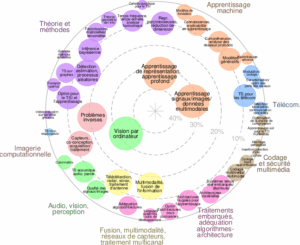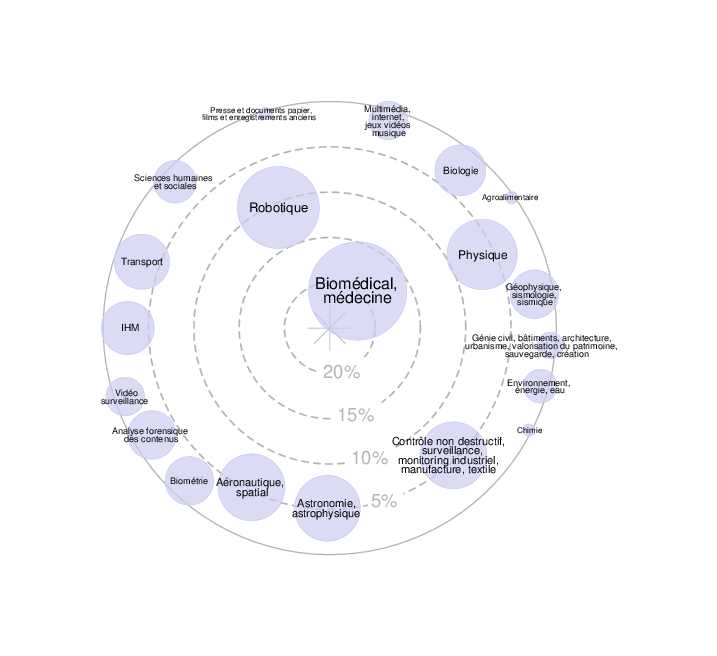Keywords: statistical modeling, physics-informed deep learning, data-driven approaches, inverse problems, hybrid approaches, instrumental modeling, nuisance modeling, multivariate data from the JWST and VLT, high-angular resolution & high-contrast imaging, exoplanet detection & characterization.
Scientific Context: The direct observation of the close environment of stars can reveal the presence of exoplanets and circumstellar disks, providing crucial insights into the formation, evolution, and diversity of planetary systems [1]. Given the very small angular separation with respect to the host star and the huge contrast between the (very bright) star and the (very faint) exoplanets and disks, imaging the immediate vicinity of a star is extremely challenging. To overcome these difficulties, advanced observational techniques are used. They include (i) extreme adaptive optics, which compensates in real time for wavefront distortions caused by atmospheric turbulence; (ii) coronagraphy, which partially blocks the star light; and (iii) observing strategies which introduce diversity among the different signals to be unmixed [2]. Dedicated processing methods that combine the recorded spatio-temporo-spectral image series form the last corner-stone of direct imaging and they aim to efficiently suppress the nuisance component (i.e., speckles and noise) corrupting the signals of interest [3]. In this context, data science developments are decisive to improve the detection sensitivity of exoplanets and the accuracy of their physical characterization.
Research Objectives: This project will build on recent advances [5-6-7] in modeling the nuisance component that corrupts high-contrast total intensity observations. The focus will be on improving exoplanet detection and characterization using data of cutting-edge ground-based and space-based telescopes. Possible research directions include:
1/ Fine modeling of the nuisance component: Modeling the spatio-temporo-spectral correlations of the nuisance component is crucial for its efficient suppression. Typically, spatial correlations are local due to speckles (resulting from diffraction in the presence of residual optical aberrations) but can also extend to larger spatial scales due to stellar light leaking from the coronagraph. Two main strategies for estimating these correlations can be explored: (i) information extraction from massive data archives using deep learning, which should provide interpretable detection scores and reliable estimates, (ii) flexible statistical models of the full-field covariance [8], with reduced complexity, learned from the science data.
2/ Integrating physics-based prior knowledge: Such information will be leveraged to condition the nuisance model by knowledge on both the image formation process and on the physics of the objects we are observing. Regarding the image formation process, the project will consider integrating instrumental (i.e., optical) models [9] in the learning process to improve the modeling of the nuisance component by, for instance, linking typical aberrations of phase maps to typical structures (e.g., symmetries) of the speckles field. Regarding the objects of interest, the project will consider generating prior information on typical exoplanet spectra. Such prior information can be leveraged from physics-based simulations that account for atmospheric chemistry and cloud presence [10]. Key research questions center on designing effective architectures and learning strategies to create and integrate these priors.
Data, Instruments, and Versatility of the Developments: This project will focus on developing new processing algorithms for total intensity observations (imaging and spectroscopy) from SPHERE; the state-of-the-art ground-based high-contrast imaging instrument on the Very Large Telescope and/or from the MIRI instrument on board the James Webb Space Telescope.
Desired Skills: The MSc candidate should have a very strong background in signal and image processing, applied mathematics, machine learning, computer vision or related fields. A strong interest in physics, pluri-disciplinary research and scientific applications is a plus.
Team and Collaborations: The MSc candidate will integrate a collaborative project between the AIRI team at the Astrophysics Research Center of Lyon and the THOTH/WILLOW teams at Inria Grenoble/Paris. The AIRI team has extensive expertise in high-angular-resolution and high-contrast imaging, both in instrumentation and data science. The THOTH and WILLOW teams have a longstanding expertise in machine learning.
Starting Date: As soon as possible with the possibility to continue within a funded PhD thesis.
Contacts: olivier.flasseur@univ-lyon1.fr, julien.mairal@inria.fr, jean.ponce@inria.fr, theo.bodrito@inria.fr
References (co-signed by members of the team in bold) :





